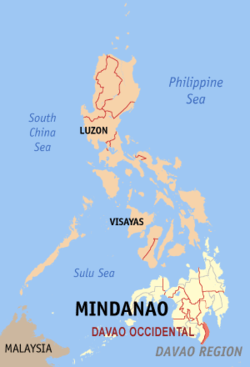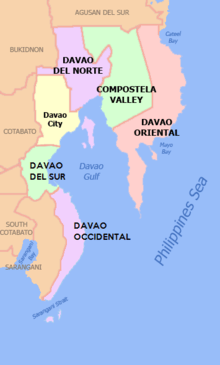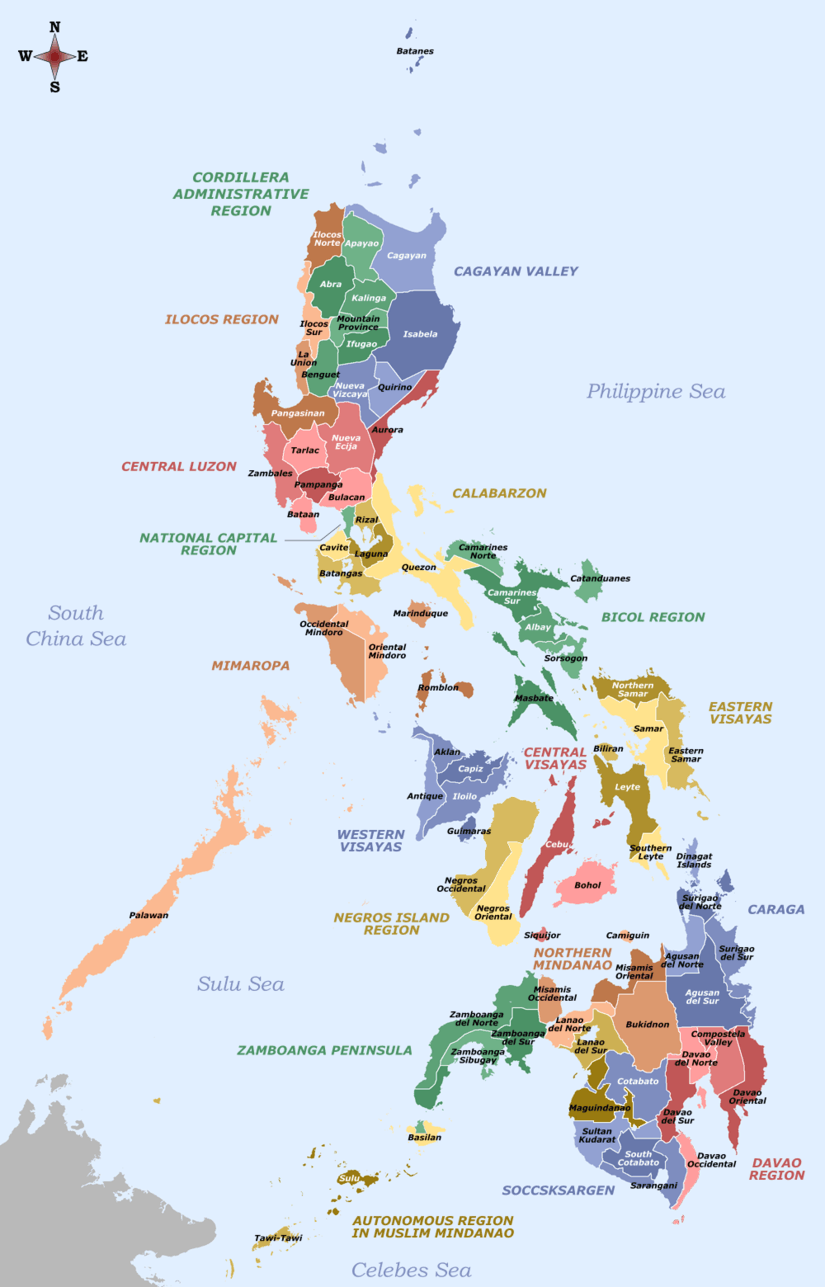Davao Occidental
| Davao Occidental | ||
|---|---|---|
| Province | ||
| Province of Davao Occidental | ||
| ||
 Location in the Philippines | ||
| Coordinates: 6°05′N 125°40′E / 6.08°N 125.67°ECoordinates: 6°05′N 125°40′E / 6.08°N 125.67°E | ||
| Country | Philippines | |
| Region | Davao Region (Region XI) | |
| Founded | October 28, 2013 | |
| Capital | Malita | |
| Government | ||
| • Type | Sangguniang Panlalawigan | |
| • Governor | Claude Bautista | |
| • Vice Governor | Franklin Bautista | |
| • Representative | Lorna Bautista-Bandigan | |
| Area[1] | ||
| • Total | 2,163.45 km2 (835.31 sq mi) | |
| Area rank | 57th out of 81 | |
| Population (2015 census)[2] | ||
| • Total | 316,342 | |
| • Rank | 65th out of 81 | |
| • Density | 150/km2 (380/sq mi) | |
| • Density rank | 59th out of 81 | |
| Divisions | ||
| • Independent cities | 0 | |
| • Component cities | 0 | |
| • Municipalities | ||
| • Barangays | 105 | |
| • Districts | Lone District of Davao Occidental | |
| Time zone | PHT (UTC+8) | |
| Spoken languages | ||
Davao Occidental (Cebuano: Kasadpang Dabaw, Filipino: Kanlurang Dabaw) is the 81st and newest province in the Philippines located in the Davao Region in Mindanao.[3][4][5] Its capital is the municipality of Malita. To the east lies the Davao Gulf. It also shares a water border with the Indonesian province of North Sulawesi to the south.
According to Article IX Section 48 of the provincial charter, the first set of elective officials were elected on May 9, 2016, the next local elections following the foundation of the province.
Creation
Davao Occidental was created through Republic Act 10360 enacted on July 23, 2013, comprising five of the eight municipalities that constitute the 2nd district of Davao del Sur. RA 10360 was passed by the House of Representatives and Senate on November 28, 2012, and December 5, 2012, respectively, and signed by President Benigno Aquino III on January 14, 2013.[3][6] A plebiscite was held on October 28, 2013 along with the barangay elections and the majority of votes cast were "Yes", ratifying the province.[4]
The motive of creating the province was to boost the economic condition and social progress of the municipalities. Senator Ferdinand Marcos Jr., who sponsored the creation of Davao Occidental, said that the distances of Digos City, Davao del Sur's provincial capital, to other municipalities in the second Congressional District are far-off that impairs the effective delivery of basic services, as well as the access to government offices.[7] However, Davao del Sur Representative Marc Douglas Cagas considered the creation of the province as nothing more than gerrymandering and political convenience.[8]
Until after elected officials of the 2016 elections assumes office, government officials of Davao del Sur with assistance from the Department of Interior and Local Government will exercise jurisdiction over the Davao Occidental.[9][10]
Geography
Davao Occidental covers a total area of 2,163.45 square kilometres (835.31 sq mi)[11] occupying the southwestern tip of the Davao Region in Mindanao. The province is bordered on the northwest by Davao del Sur; west by Sarangani and northeast by the Davao Gulf.
Administrative divisions
The province comprises 5 municipalities, all encompassed by a lone legislative district.[11]
| Municipality [lower-roman 1] | Population | ±% p.a. | Area[11] | Density | Brgy. | |||||||
|---|---|---|---|---|---|---|---|---|---|---|---|---|
| (2015)[2] | (2010)[12] | km2 | sq mi | /km2 | /sq mi | |||||||
| 6°12′02″N 125°41′40″E / 6.2005°N 125.6945°E | Don Marcelino | 14.1% | 44,554 | 41,942 | +1.16% | 407.30 | 157.26 | 110 | 280 | 15 | ||
| 5°54′46″N 125°38′39″E / 5.9129°N 125.6441°E | Jose Abad Santos | 24.1% | 76,332 | 69,631 | +1.76% | 600.06 | 231.68 | 130 | 340 | 26 | ||
| 6°24′40″N 125°36′30″E / 6.4110°N 125.6082°E | Malita | † | 37.2% | 117,746 | 109,568 | +1.38% | 883.37 | 341.07 | 130 | 340 | 30 | |
| 6°33′13″N 125°28′27″E / 6.5537°N 125.4742°E | Santa Maria | 17.0% | 53,671 | 49,349 | +1.61% | 175.00 | 67.57 | 310 | 800 | 22 | ||
| 5°24′44″N 125°25′17″E / 5.4123°N 125.4215°E | Sarangani | 7.6% | 24,039 | 23,290 | +0.60% | 97.72 | 37.73 | 250 | 650 | 12 | ||
| Total | 316,342 | 293,780 | +1.42% | 2,163.45 | 835.31 | 150 | 390 | 105 | ||||
| † Provincial capital | Municipality | |||||||||||
| ||||||||||||
Demographics
The population of Davao Occidental in the 2015 census was 316,342 people,[2] with a density of 150 inhabitants per square kilometre or 390 inhabitants per square mile.
| Population census of Davao Occidental | |||||||||||||||||||||||||
|---|---|---|---|---|---|---|---|---|---|---|---|---|---|---|---|---|---|---|---|---|---|---|---|---|---|
|
| ||||||||||||||||||||||||
Sources:
| |||||||||||||||||||||||||
See also
References
- ↑ "Province: Davao Occidental". PSGC Interactive. Makati City, Philippines: National Statistical Coordination Board. Retrieved 15 April 2014.
- 1 2 3 4 "Region XI (DAVAO REGION)". Census of Population (2015): Total Population by Province, City, Municipality and Barangay (Report). PSA. Retrieved 20 June 2016.
- 1 2 "Republic Act No. 10360; An Act Creating the Province of Davao Occidental". Official Gazette of the Republic of the Philippines. Metro Manila, Philippines: Congress of the Philippines. 14 January 2013. Retrieved 24 July 2016.
- 1 2 Cayon, Carina L. (30 October 2013). "DavSur voters approve of Davao Occidental". Philippine Information Agency. Retrieved 7 November 2013.
- ↑ "Davao Occidental, PH's 81st province". Manila Bulletin. Yahoo! News Philippines. 31 October 2013. Archived from the original on 4 November 2013. Retrieved 24 July 2016.
- ↑ "COMELEC to conduct plebiscite for the creation of Davao Occidental". Official Gazette. COMELEC. September 18, 2013. Retrieved 7 November 2013.
- ↑ "Davao Occidental Province Soon To Be Realized". Senate of the Philippines. May 16, 2012. Retrieved 7 November 2013.
- ↑ Regalado, Edith (January 24, 2013). "'Creation of Davao Occidental just for political convenience'". philSTAR.com. Retrieved 7 November 2013.
- ↑ Carillo, C.A. (10 November 2013). "Davao Occidental province to be created". BusinessWorld. Retrieved 27 January 2016.
- ↑ "Plebiscite results favor new Davao province". Philippine Daily Inquirer. 30 October 2013. Retrieved 27 January 2016.
- 1 2 3 "Province: Davao Occidental". PSA. Philippines: National Statistical Coordination Board. Retrieved 8 January 2016.
- 1 2 "Region XI (DAVAO REGION)". Census of Population and Housing (2010): Total Population by Province, City, Municipality and Barangay (Report). NSO. Retrieved 29 June 2016.
- ↑ "Region XI (DAVAO REGION)". Census of Population (1995, 2000 and 2007): Total Population by Province, City and Municipality (Report). NSO. Archived from the original on 24 June 2011.
External links
-
 Media related to Davao Occidental at Wikimedia Commons
Media related to Davao Occidental at Wikimedia Commons -
 Geographic data related to Davao Occidental at OpenStreetMap
Geographic data related to Davao Occidental at OpenStreetMap - Republic Act No. 10360: "Charter of the Province of Davao Occidental"
 |
Davao del Sur | Davao Gulf / Davao Oriental |  | |
| Sarangani | |
Philippine Sea | ||
| ||||
| | ||||
| Celebes Sea |



